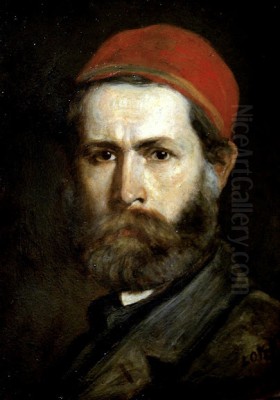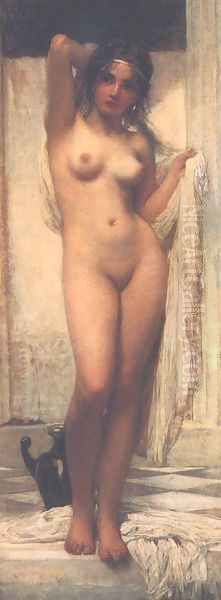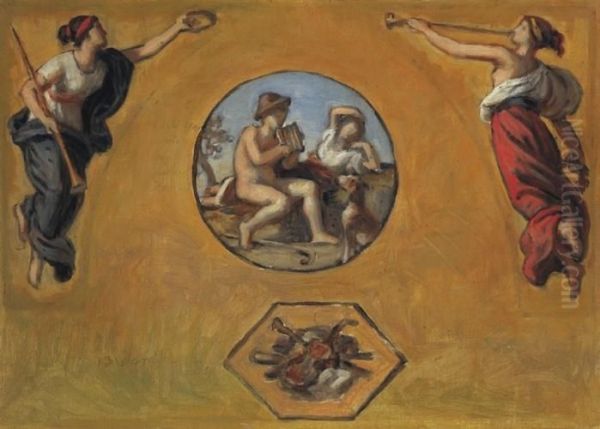
Károly Lotz stands as one of the most significant and celebrated painters in 19th-century Hungarian art history. A master of monumental murals, sensitive portraits, and evocative landscapes, Lotz navigated the prevailing currents of Historicism and Romanticism, leaving an indelible mark on the cultural landscape of Hungary, particularly in its rapidly developing capital, Budapest. His dual German-Hungarian heritage and extensive training provided a foundation for a career characterized by technical brilliance, academic discipline, and a profound connection to the artistic and architectural projects that defined his era.
Early Life and Artistic Formation
Born Karl Anton Paul Lotz on December 16, 1833, in Bad Homburg vor der Höhe, Germany, his life path soon led him eastward. He was the youngest child of Wilhelm Christian Lotz and Antoni Hohlfeld. Following his father's death, his mother moved the family to Pest (later part of Budapest), Hungary. This relocation proved pivotal, immersing the young Lotz in the cultural milieu that would become the primary stage for his artistic achievements. He became a citizen of Hungary, fully integrating into its artistic life.
Lotz's formal artistic education began at the Piaristengymnasium in Pest. His talent was evident early on, leading him to pursue more specialized training. He initially studied historical painting in Venice, under the tutelage of Giacomo Marastoni, absorbing the rich traditions of Venetian color and composition. Returning to Hungary, he continued his studies in Budapest, learning from Henrik Weber, a notable figure in Hungarian Romantic painting.
A crucial phase in his development occurred in Vienna, where he joined the prestigious studio of Karl Rahl. Rahl was a leading exponent of Historicism and a master of monumental painting, known for his work on Vienna's Ringstrasse buildings. Under Rahl's guidance, Lotz honed his skills in large-scale composition, anatomical precision, and the deployment of historical and allegorical themes – skills that would become central to his later career as a muralist. This period exposed him to the grand academic traditions favored in the Austro-Hungarian Empire.
Artistic Style: Historicism, Romanticism, and Realism

Károly Lotz's artistic output is primarily associated with Historicism, the dominant academic style of the latter half of the 19th century. This approach involved drawing inspiration from historical periods and styles, often combining elements from the Renaissance, Baroque, and Neoclassicism to create grand, often didactic or celebratory, compositions. Lotz excelled in this mode, demonstrating a deep understanding of art history and an ability to synthesize various influences into a coherent and impressive whole.
However, his work is not solely defined by academic Historicism. A strong current of Romanticism runs through much of his art, particularly visible in his landscapes and certain genre scenes. This is evident in his sensitivity to atmosphere, his dramatic use of light and shadow (chiaroscuro), and his ability to convey emotion, whether in the turbulence of a storm or the quiet dignity of a portrait subject. His landscapes, such as Lake Lovats (1870) or the dramatic Thunderstorm over the Puszta, showcase this Romantic affinity for nature's power and beauty.
Complementing these broader stylistic tendencies was Lotz's commitment to detailed Realism. His figures are rendered with anatomical accuracy, his textures are meticulously described, and his portraits capture not only a physical likeness but also a sense of the sitter's personality and social standing. This careful observation and technical precision lent credibility and immediacy to his historical and allegorical scenes, grounding even the most elevated subjects in tangible reality. His brushwork, while often refined and smooth in the academic manner, could also be expressive when the subject demanded it.
Monumental Murals: Adorning Budapest's Landmarks
Károly Lotz is perhaps best remembered for his monumental frescoes and murals that adorn some of Budapest's most important public buildings, created during a period of intense urban development and national self-expression following the Austro-Hungarian Compromise of 1867. These commissions cemented his reputation as a leading artist of his time.
One of his early significant mural projects was for the staircase of the Hungarian National Museum in Budapest. This work helped establish his credentials as a painter capable of handling large-scale decorative schemes that integrated seamlessly with architecture.
His collaboration with fellow artist Mór Than on the decorations for the Vigadó Concert Hall in Budapest was another major undertaking. Their ceiling paintings contributed to the opulent interior of this important cultural venue, showcasing themes appropriate for a place of music and festivity.

Lotz's contributions to the Hungarian State Opera House, inaugurated in 1884, are among his most admired works. Working alongside other prominent artists like Bertalan Székely and Mór Than, Lotz painted significant portions of the ceiling frescoes, including the stunning central chandelier dome depicting the Greek gods on Mount Olympus. These vibrant, dynamic compositions perfectly complement the Neo-Renaissance splendor of the building designed by Miklós Ybl.
Perhaps his most extensive mural project was within the Hungarian Parliament Building, a grand symbol of Hungarian statehood designed by Imre Steindl. Lotz was responsible for significant decorative cycles, including ceiling paintings and frescoes in key areas like the grand staircase. These works often employed allegory to represent concepts like law, justice, and the glory of Hungary. A notable late work here is the Apotheosis of the Habsburg Dynasty (also known as Glorification of the Habsburgs, 1903), a complex ceiling piece reflecting the political realities of the Dual Monarchy, executed in a rich, almost Baroque style.
Lotz also contributed murals to other significant institutions, including the Hungarian Academy of Sciences and St. Stephen's Basilica in Budapest, further solidifying his role as the preeminent decorative painter for the nation's key architectural projects.
Portraiture, Landscape, and Genre Painting
While celebrated for his murals, Károly Lotz was also a highly accomplished painter of easel works, including portraits, landscapes, and genre scenes. His portraits were sought after by the aristocracy and prominent figures of Hungarian society. He possessed a keen ability to capture the likeness and character of his sitters, often imbuing them with a sense of dignity and psychological presence. Notable examples include the elegant Portrait of Countess Ilona Almásy (1889) and the regal Portrait of Queen Elisabeth with her Daughter Archduchess Marie Valerie (1899).
His landscapes often reveal the more Romantic side of his artistic personality. Works like Horses in a Storm (1862) demonstrate his skill in depicting dramatic natural phenomena and animal anatomy with energy and flair. His depictions of the Hungarian landscape, such as the Puszta (the great plains), captured the unique atmosphere of the region. He also painted more intimate nature studies, like Roses (1882), showcasing his sensitivity to color and form in the natural world.

Lotz explored various other themes throughout his career. He painted genre scenes, such as Woman Bathing, which allowed for the depiction of the human form in a more intimate, often idealized context. He also undertook religious commissions, like the portrait of St. John of Capistrano, demonstrating his versatility across different subject matters demanded by patrons and institutions. Works like The Tracker further illustrate his interest in narrative and scenes from Hungarian life or history. His powerful Allegory of Fire (1883), an oil on canvas, is another testament to his skill in handling complex allegorical subjects with dynamism and technical mastery.
Teaching and Influence on Hungarian Art
Beyond his prolific output as a painter, Károly Lotz played a significant role in Hungarian art education. He was associated with the precursor institutions to the Hungarian University of Fine Arts, serving as a professor and, eventually, as the director of the Hungarian Royal Drawing School. His position placed him at the center of artistic training in the country for several decades.
In 1885, Lotz became the head of a newly established department specifically for women painters, indicating a progressive stance within the context of 19th-century art education. He was known as a dedicated teacher who influenced generations of Hungarian artists, although pinpointing specific famous pupils directly attributed to his sole mentorship can be complex, as many prominent artists of the next generation were colleagues or studied under multiple masters within the academy system.
His influence extended through his adherence to strong academic principles – emphasizing drawing, composition, and technical proficiency – which formed the bedrock of official art training in Hungary during his tenure. While later movements like Impressionism and Art Nouveau (known as Secessionism in Hungary and Austria) would challenge the academic tradition, Lotz's work and teaching represented the pinnacle of 19th-century Hungarian Historicism and Romantic Realism.
Contemporaries and Artistic Context
Károly Lotz did not work in isolation. He was part of a vibrant generation of Hungarian artists who contributed to a flourishing national art scene in the latter half of the 19th century. His career overlapped and intersected with several key figures.
He collaborated directly with Mór Than on major mural projects, highlighting the cooperative nature of large-scale decorative commissions. He worked alongside Bertalan Székely, another giant of Hungarian history painting and muralism, particularly at the Opera House. Both Székely and Lotz represented the high point of monumental historical painting in Hungary.
Other important contemporaries included Miklós Barabás, a leading portraitist of the earlier generation, and Gyula Benczúr, another highly successful history painter who also studied under Karl Rahl and achieved international recognition. While stylistically distinct, the immensely famous Mihály Munkácsy was also a contemporary, though his path led more towards Realism and dramatic genre scenes, often painted in Paris.
Lotz's Viennese training connected him to the broader artistic trends of the Austro-Hungarian Empire, including the circle around his teacher Karl Rahl and the opulent style associated with painters like Hans Makart, whose influence permeated the decorative arts of the era.
Towards the end of Lotz's life, the artistic landscape began to shift with the rise of the Hungarian Secessionist movement (Art Nouveau). Figures like the architect Ödön Lechner and painters such as József Rippl-Rónai introduced new styles that broke from the academicism Lotz represented. While Lotz remained largely faithful to his established style, his later works sometimes show a richness of color and decorative sensibility that hints at the changing aesthetic environment.
Legacy
Károly Lotz passed away in Budapest on October 13, 1904. He left behind a legacy as one of Hungary's most important and prolific academic painters. His monumental murals remain integral parts of the nation's most cherished architectural landmarks, defining the visual culture of late 19th-century Budapest. His portraits provide a valuable record of the era's prominent figures, while his landscapes and other easel paintings demonstrate his technical versatility and artistic sensitivity.
As a professor and director at the national art academy, he shaped the training of countless artists, upholding the standards of academic excellence. While artistic styles evolved after his death, Lotz's mastery of composition, his dedication to craft, and his immense contribution to Hungary's public art ensure his enduring significance in the history of European art. His works continue to be admired for their technical brilliance, their historical importance, and their embodiment of the aspirations and aesthetics of his time.